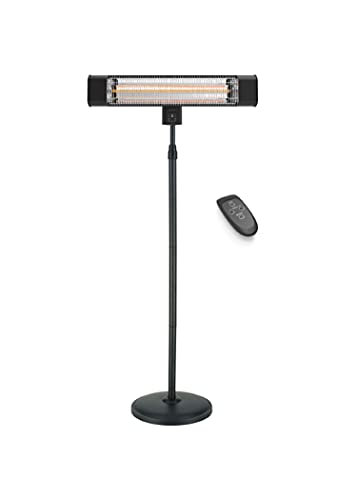How to Choose a Patio Heat Lamp Electric
When you're looking to heat your patio, you've got several options. In contrast to propane heaters that require refills electric heaters can provide instant heat by simply flipping an switch or pressing the button.
They don't emit gasses which could pose a health hazard. Certain units come with adjustable heat settings to accommodate varying distances.
Type of Heater
You can relax outside well into the evening and throughout the year with the proper patio heater. Patio heaters are available in a variety of varieties that include freestanding propane or natural gas models and ceiling or wall mounted electric radiant heaters. Your choice depends on the size of your patio, existing power sources and individual preferences.
Most patio heaters use electricity, liquid or natural gas to generate heat. outdoor heater for patio electric emit heat via convection heating as well as radiant heating. outdoor electric heater patio is measured in watts and can be converted to British thermal units (BTUs) to compare. Some models have adjustable temperature settings that give you more flexibility.
A patio heat lamp is the burner on top of a pole with a perforated metal screen that is reflective of the flames and radiates the heat downward to warm people, furniture and other objects. Some outdoor heat lamps have reflective reflectors on top of the burner that can be silvered in order to reduce the amount that heat is lost upwards.
The most common type of patio heater that is a gas patio heater, is often seen in outdoor seating areas of bars and restaurants since they generate a lot of heat quickly and spread equally across all directions -- great for warming tables. They can be portable and run off the propane tank or plugged into your natural gas line, with the latter providing more convenience and lower upfront cost of installation, but requiring an ongoing cost of fuel.
A increasing number of homes are fitted with natural gas lines, making them the perfect solution for those who prefer to use a gas patio heater. They're easy to install, but require a specialized and functioning gas line to operate safely. Portable natural gas heaters are available with extension hoses that can help overcome this issue, however these can be a tripping danger and could create an additional fire hazard when not in use.
Safety

Most electric patio heaters are suitable for use in covered areas due to their ability for heat to radiate outward, instead of upward toward material that is combustible, such as the roof. They are not intended to be used under a non-protected roof. The heater must be located at least 6" away from the ceiling, or 18" away from the wall adjacent to avoid fire hazards.
The propane and gas patio heaters are generally only suitable for use in enclosed areas with the proper cover specifically designed for use in open air. These covers are typically made of fire-resistant canvas and have an open roof that can be closed. The safety issues with these kinds of outdoor patio heaters are related to the flame and fumes they release. They should be kept away from objects that ignite, such as chairs and curtains.
When installing an electric patio heat lamp or any kind of patio heater, make sure you follow the manufacturer's directions and safety guidelines carefully. Make sure you select one that has UL and CSA certifications. Also, read the owner's guide carefully. Make sure that the heater is out of reach of children and pets. Some patio heaters that stand on their own like EUROM's include a tipping safety feature that shuts off the device if it falls.
If your patio heater uses a natural gas line it is essential to inspect the condition of the line regularly and have it tested for leaks by a qualified professional. If the line needs to be replaced then you should hire a licensed plumbing professional. A professional can determine if the line has been properly routed or should be routed through an underground pipe. In addition, a professional can also make sure the patio heater is plugged into an outlet that's GFCI (ground fault circuit interrupter) designed to guard against electrical fires and shocks.
Installation
The height of the patio heater determines the amount of heat it emits into the space. The heater should be positioned away from surfaces like wood and plastic that can deform. Depending on the model of heater you may choose to mount it on a wall or structure using standard mounting brackets. Some models feature soft starters that reduces the peak current to protect your circuits.
